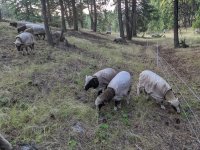Linda Poole
NCAT Regenerative Grazing Specialist
Listen in on this short National Public Radio piece by Jonathon Ahl on silvopasture:
If you see a cow out grazing in the Midwest, most likely it's in an open pasture that used to be a forest. Clear-cutting trees made it easier to raise cattle. It also eliminated much of the landscape known as Midwestern Savannas. As Saint Louis Public Radio's Jonathan Ahl reports, an experimental farm in Missouri is trying to prove that moving grazing animals back to forests is better for the environment, for farmers and for cattle.
Listen to the whole story at https://www.npr.org/2022/08/17/1117...-help-climate-change-farmers-and-the-livestocBruce Carney raises cattle on his family farm north of Des Moines. More than 10 years ago, he decided to convert 200 acres from corn and soybean fields to land for cattle to graze on.
BRUCE CARNEY: What I learned was that I needed trees. I needed windbreaks. I needed shade. I needed a living barn. To me, that's what trees do for you.





